Authors
Kelly Flaherty

Kelly Flaherty is a program manager and research associate with the China Power Project at the Center for Strategic and International Studies (CSIS). She works on a variety of projects focused on Chinese foreign and security policy, US-China bilateral relations, and cross-strait relations. Prior to joining CSIS, she was a marketing and recruiting manager at the Ameson Foundation, a nonprofit organization dedicated to creating educational and cultural exchange opportunities between the US and China. Flaherty graduated from Harvard University with a B.A. in East Asian Studies, concentrating on China and government.
Articles by Kelly Flaherty
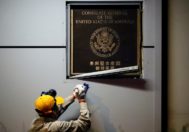
US - China
May — August 2020US-China Relations in Free Fall
President Trump blamed China for the spread of the coronavirus, which opened the door to tougher US policies on a range of issues from Hong Kong to Xinjiang. The Phase One trade deal remained intact, although Chinese purchases of US goods lagged targets in the agreement. Senior Trump administration officials delivered a series of speeches that condemned Chinese policies and suggested that the CCP poses an unacceptable threat to the United States and other democracies. Charging that the Chinese consulate in Houston was engaged in espionage, the US demanded it be closed. Beijing retaliated by shutting down the US Consulate in Chengdu. The US aligned its South China Sea policy more closely with the July 2016 tribunal ruling and declared China’s “nine-dash line” claim and actions based on it to be illegal. Tensions increased over Taiwan as the US took several steps to strengthen ties with Taipei and deter Chinese coercion. China’s imposition of national security legislation in Hong Kong resulted in the US levying sanctions on Hong Kong officials and the suspension of most US bilateral agreements with the former British Colony. A meeting between Secretary of State Mike Pompeo and Chinese Politburo Member Yang Jiechi in Hawaii did little to slow the downward slide in US-China relations.
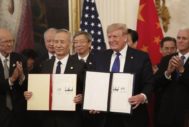
US - China
January — April 2020US-China Relations Hit New Lows Amid Pandemic
The COVID-19 virus sent US-China relations into a tailspin as 2020 opened. Recriminations flew over who was responsible for the virus that killed hundreds of thousands of people and brought economic activity to a halt. The Trump administration took a series of measures against Chinese media organizations and journalists in the United States, which provoked Beijing to expel US journalists working in China. The Phase 1 trade deal was signed, and some tariffs were lifted, though the COVID-19 outbreak hampered China’s ability to purchase the promised amount of US goods and services. With the 2020 US presidential election picking up speed, Trump campaign strategists are actively targeting China.
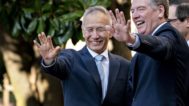
US - China
September — December 2019“Phase One” Trade Deal Reached, But Unlikely to Defuse Tensions
The US and China reached a “phase one” trade deal that includes low-hanging fruit and postpones contentious issues. Sources of friction in the bilateral relationship included President Donald Trump’s signing into law the Hong Kong Human Rights and Democracy Act, US Navy operations enforcing freedom of navigation in the South China Sea, US support for Taiwan, and China’s arbitrary detention of Xinjiang Uighurs in internment camps. A tweet by the NBA’s Houston Rockets general manager supporting protesters in Hong Kong triggered an unexpected controversy. Top US and Chinese defense leaders met on the margins of the ASEAN Defense Minister’s Meeting-Plus in Bangkok and a joint humanitarian rescue and disaster relief exercise took place in Hawaii. The US continued to take measures to crack down on Chinese espionage.
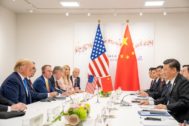
US - China
May — August 2019The Trade Deal Falls Through
US-China trade talks collapsed after China reneged on a significant portion of a draft agreement that had been painstakingly written by US and Chinese negotiators. After Donald Trump and Xi Jinping met on the sidelines of the G20 in Osaka, talks resumed but failed to make progress. Acting Secretary of Defense Patrick Shanahan met Defense Minster Wei Fenghe and both delivered speeches at the Shangri-La Dialogue in Singapore. The US sold two arms packages to Taiwan totaling over $10 billion, which included M1A2T Abrams tanks, 250 Stinger missiles, and 66 F16V fighter jets. The 26th ASEAN Regional Forum (ARF) provided an opportunity for Secretary of State Mike Pompeo and Foreign Minister Wang Yi to meet. The navies of both the US and China conducted drills in the South China Sea, and US Navy ships conducted three freedom of navigation operations (FONOPs) in the Spratlys. Pro-democracy demonstrations in Hong Kong began in early June and continued throughout the summer with spasms of violence by Hong Kong police and protesters. Beijing accused the US of being behind the protests, a charge that Washington adamantly denied.
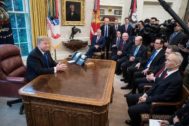
US - China
January — April 2019Is a Trade Deal Imminent?
Intense trade talks in the first four months of 2019 made progress, raising hopes that a deal will be reached in May, and signed by Presidents Donald Trump and Xi Jinping soon thereafter. Remaining sticking points include the enforcement mechanism, which is a key US demand, and a schedule for lifting the tariffs, which is a Chinese priority. The US Department of Justice unsealed an indictment charging Huawei and its CFO Meng Wanzhou with financial fraud, money laundering, obstruction of justice, sanctions violations, and other crimes. Tensions increased over Taiwan as the Trump administration took steps to strengthen ties with Taipei and warn Beijing to back off its coercive and destabilizing policies. President Trump welcomed China’s decision to add fentanyl-related substances to a supplementary list of controlled drugs and substances beginning May 1. Growing US concerns about Chinese espionage were highlighted publicly in speeches by senior Trump administration officials.
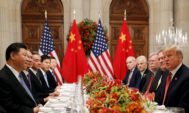
US - China
September — December 2018A Deal is Struck in Buenos Aires
On the sidelines of the G20 summit, Donald Trump and Xi Jinping put tariff hikes on hold and agreed to resume trade negotiations. Prior to the agreement, the US-China spat spilled over into the multilateral arena causing the first-ever failure to reach a joint communique at the Asia-Pacific Economic Cooperation (APEC) meeting in Port Moresby, Papua New Guinea. The imposition of sanctions by the US on the People’s Liberation Army’s Equipment Development Department and its director resulted in a temporary setback in military ties. The US took actions against Chinese individuals and hacking rings for allegedly stealing US technology to gain commercial advantage. The second US-China Diplomatic and Security Dialogue was held in Washington DC. Trump and Xi talked by phone in November and December.
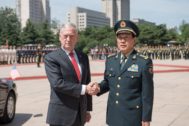
US - China
May — August 2018Tit-for-Tat Tariffs
Negotiations to resolve US-China trade friction failed to produce an agreement and the US-China trade war entered into high gear as both sides imposed tariffs on large quantities of imported goods from the other. President Donald Trump and President Xi Jinping kickstarted their relations with North Korea and held separate meetings with Kim Jong Un. Trump later accused China of undermining progress in US-North Korea negotiations. Secretary of Defense James Mattis traveled to Beijing in mid-June, the first visit to China by a US defense secretary since 2014. On Aug. 13, Trump signed into law the FY2019 National Defense Authorization Act (NDAA), which requires the president to develop a whole-of-government strategy toward China, including how to respond to China’s influence operations, cyber activities, Belt and Road Initiative (BRI), and use of economic tools to gain access to sensitive US industries. The Trump administration pushed back against Chinese bullying of Taiwan.

US - China
January — April 2018Hurtling Toward a Trade War
The US and China engaged in tit-for-tat trade actions as bilateral trade talks failed to produce a compromise. The Trump administration doubled down on its characterization of China as a threat to US interests in the National Defense Strategy and “Worldwide Threats” hearings on Capitol Hill. President Trump signed the Taiwan Travel Act, which calls for the US government to encourage visits between officials from the United States and Taiwan at all levels, provoking China’s ire. Cracks in US-China cooperation on North Korea were revealed as the Trump administration imposed sanctions on Chinese shipping and trading companies allegedly conducting illicit business with North Korea, and Beijing failed to notify Washington in advance of Kim Jong Un’s visit to China. The US conducted two Freedom of Navigation Operations (FONOPS) in the South China Sea.